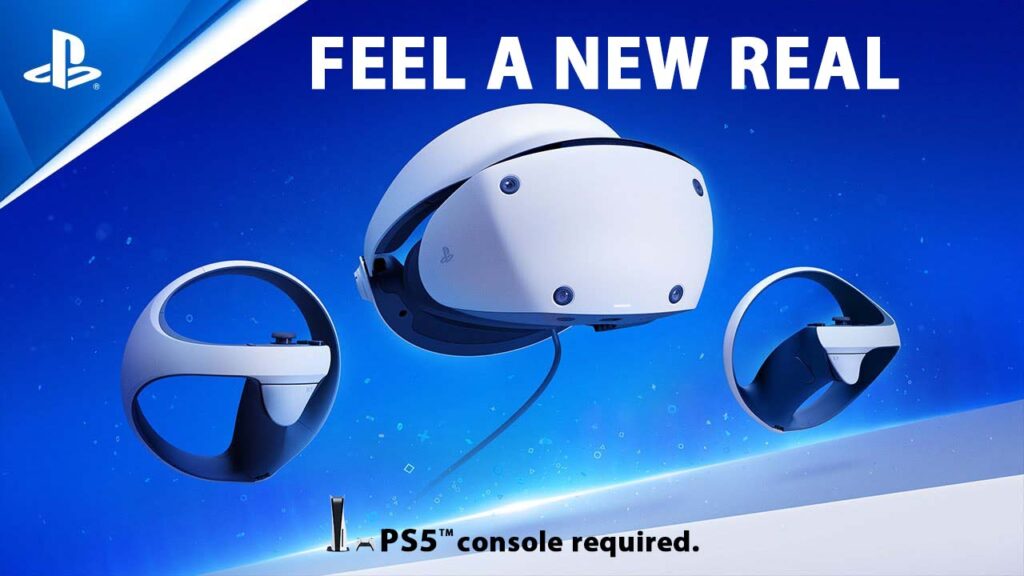PlayStation VR 2: The Next Level of Gaming, Fueled by Horizon Call of the Mountain
The original PlayStation VR was a commendable first attempt by Sony, but it had some shortcomings as a clunky piece of hardware. It was launched during the early days of consumer-focused headsets, which allowed Sony to combine old and new technology in a makeshift manner. Despite its sleek appearance & comfortable design, the displays were subpar, setup was frustrating, and it used controllers that were a generation behind the PS4. In essence, the PSVR felt like a hastily put together solution to capitalize on an emerging trend.

The PlayStation VR 2 is a well-conceived piece of hardware that offers powerful technology, and an almost entirely seamless, user-friendly, plug & play experience. It is equipped with modern technology, which makes it a suitable companion for the PlayStation 5, and its Sense controllers are tailored specifically for gaming in VR spaces. The PSVR 2 represents a significant leap forward for PlayStation’s VR ambitions and is one of the finest headsets available on the market. Anyway, given the ever-changing VR landscape, its pricing and current value proposition leave it in a somewhat awkward position once again.
Right out of the box, the PSVR 2 boasts a premium & stylish design. The PlayStation’s signature matte-white-on-deep-black color scheme is carried over, and complemented by the headset’s rounded corners and curved bands, giving it an overall sleek look and feel. The Sense controllers are also elegantly designed, fitting comfortably in the hands, and allowing the fingers & thumbs to rest naturally on the buttons and triggers. The original PSVR was known for its exceptional comfort, and the PSVR 2 takes that to the next level, making it even more comfortable to wear. While it may feel slightly heavier than the Meta Quest 2, the weight is distributed evenly, and neck fatigue is not an issue during longer sessions.
The PSVR 2 has some impressive product design features that may seem small but make a significant difference in everyday use. For example, the headphones that come with the headset plug into the band, and have a slim plastic body that contours around it. This design gives the headphones a seamless look, and they appear to be part of the headset until the ends, where a small stretch of wire and in-ear headphones hang. On each side of the band, there are two notches that secure the headphones in place, similar to little finger traps. It is effortless to put the headphones in, take them out and store them without removing the headset, enhancing the user’s overall experience.
The PSVR 2 is designed for comfort, and ease of use, with features that set it apart from other virtual reality headsets. Adjusting the headset is made easy with buttons to move the lenses and the band, and a dial to align the lenses with your eyes. The headset’s mixture of hard plastic & cushioning provides sturdiness, and comfort that other headsets can’t match without purchasing additional accessories.
Setting up the PSVR 2 is simple, requiring only a single wire to be plugged into the front of the PS5 and physically plugging in the Sense controllers once to pair them. The PSVR 2’s inside-out tracking via the four cameras on the headset quickly scans, and maps the room around you, defining a safe play space that takes into account any nearby objects. The process is streamlined, requiring minimal interaction from the user beyond tutorial prompts, and informational text boxes.
The original PSVR’s complicated setup, the PSVR 2’s setup is straightforward and user-friendly. Overall, the PSVR 2 is an excellent headset for those looking for a comfortable and easy-to-use VR experience.
Naturally, creating an optimal environment for the PSVR 2 involves having a clear & open space where you can move around freely without obstruction. Additionally, Its important to have ample lighting so that the headset’s cameras can track your movements. The most users won’t have access to perfect conditions, and in many cases, you’ll need to work with the space you have available. In my case, I played between a couch and a chair, with a coffee table in front of me, giving me only about a foot of space. My lighting came from bay windows during the day, and a standard lightbulb at night. Despite these less-than-ideal conditions, I had a relatively smooth experience with the headset.
Compared to the Quest 2’s wireless freedom, being tethered to the PS5 was a bit annoying at first, and it limits your range of movement. Additionally, part of my attention was always focused on not getting too engrossed in the game, as I didn’t want to accidentally pull the console off its perch. The trade-off is being able to take advantage of the PS5’s power, which allows for more ambitious games. The only significant issue I encountered in my suboptimal environment was inconsistent finger-tracking with the Sense controllers, which resulted in some unexpected movements in-game. This problem seemed more pronounced in the evenings when there was less light. Nonetheless, it wasn’t a significant problem, just a minor inconvenience.
One of the standout features of the PSVR 2 for me is a button located on the underside of the headset. When pressed, it pauses the game & switches the display to show a view of the room around you. Although the image quality of this view is not the best, and looks more like a night vision camera, it is still incredibly useful for safely navigating your surroundings. This feature is particularly handy for picking up or putting down controllers, reorienting yourself, or just checking on your pet. By taking advantage of the external cameras on the headset, this is a prime example of how the PSVR 2 hardware can enhance the user experience.
The process of setting up the PSVR 2 is quick and effortless, thanks to its seamless integration into the PlayStation ecosystem. Unlike with other VR headsets that require the creation of new accounts or complicated account merges, the PSVR 2 leverages your existing PlayStation account, making the experience completely frictionless. In just a few minutes, you can take the headset out of the box & start playing games. The simplicity of the setup process is a welcome relief compared to the hassle of dealing with accounts, and migrations for other VR headsets.
Horizon Call of the Mountain is undoubtedly the standout game for the PSVR 2. This game showcases just how exceptional a high-quality VR experience can be when running on powerful hardware. Although the technical specifications for the PSVR 2 are readily available, the result of all that technology is evident in the beauty of Call of the Mountain. Its easily one of the best-looking VR games available and it fully utilizes every feature the PSVR 2 has to offer. The OLED displays, and advanced techniques such as foveated rendering deliver stunning visuals that are rich, vibrant and incredibly detailed, without compromising performance. The PSVR 2 provides players with an intimate, and immersive experience that withstands scrutiny, whether you’re gliding oars through water, swaying trees in the wind, or exploring a rough, and craggy mountainside. The ability to get up close, and personal with robotic dinosaurs highlights the superb creature design work that Guerrilla put into the game, as well as the stunning world-building.
I previously described the feeling of being in the world of Horizon as awe-inspiring, and this sensation holds true now too. That is, for me, the enduring magic of VR. There’s nothing quite like the feeling of using the Sense controllers to carefully grasp handholds to climb my way up the side of a towering structure, only to glance over my shoulder, and have the virtual world momentarily override my sights and senses to make me believe in the peril that awaited me should I take one wrong step. Or taking out enemies by quickly reaching over my shoulder to pull out arrows, and carefully lining up shots to hit weak points, and then marvelling at the physicality and instinct that went into doing that while ducking under lasers, and narrowly leaping out of the way of robotic claws. Playing Horizon Call of the Mountain makes the PSVR 2 sing and Its a beautiful song.
But even with its impressive execution, I couldn’t help but reflect on the lack of progress in VR experiences since they first became available. Fire sprite, the developer of Horizon Call of the Mountain, has done an excellent job of implementing the established VR gameplay mechanics, and ideas into a AAA VR title. The game provides a highly immersive virtual tour of a fantasy world, delivers one of the best climbing experiences available, offers satisfying bow-and-arrow combat, and even includes a story that fans of the Horizon franchise will appreciate. Anyway, each of these elements can be found elsewhere, in other experiences, and on other devices and I’ve already experienced them many times before.
That leads me to the most significant obstacle facing the PSVR 2: there’s nothing that truly sets it apart from the competition. Yes, the headset is state-of-the-art and the Sense controllers with finger-tracking capabilities are both capable & comfortable, even if they’re used in predictable ways. VR games still feel like they’re stuck in the same small box of possibilities that they were in when the Rift hit the market all those years ago, with the exception of a few limited cases, such as Half-Life Alyx. There’s nothing wrong with these ideas, just as there’s nothing wrong with taking existing games like Gran Turismo or Resident Evil Village, and using VR to create new ways to play them. But the question then becomes, is that enough for you? And is that enough if it’s all it will ever be?
At a price point of $550–not including the cost of the PS5 it requires–this is an important question to consider, particularly at launch when the PSVR 2 feels more like a luxury item than a necessary gaming platform. For some, spending that much money to have the most up-to-date technology is all the justification they require. Anyway, for those who are serious about immersing themselves in the world of virtual reality, the PSVR 2 may not be an easy recommendation at the moment.
As previously mentioned, while Horizon Call of the Mountain impressed me, no other game left quite the same impact. Kayak VR Mirage allowed me to navigate through various real-world environments, including day, night and stormy conditions. Although it was impressive to experience these locations in virtual reality, the excitement was short-lived as there is only so much paddling, I want to do in my leisure time. Cities VR allowed me to construct my own metropolis using the Sense controllers, from laying down roads to managing the daily activities of my virtual city. The novelty of creating my own city soon wore off, and I did not find myself returning to it repeatedly.
The experience of playing Horizon Call of the Mountain was enjoyable, but it failed to leave a lasting impression on me. While playing other VR games such as Kayak VR Mirage or Cities VR, I was left wanting something more. I longed for a game that would charm me in the same way Astro Bot did, or show me something revolutionary that could only exist in a VR game. While it may be a tall order, its exactly what PlayStation designers and developers need to do in order to stand out in a crowded VR market that offers cheaper options. Its saying that the games I enjoyed the most were either old or available on other platforms. Moss and Moss Book 2 were delightful experiences that I regretted missing out on. Tentacular, a game that let me use eye-tracking and Sense controllers to interact with quirky characters and objects, was funny and creative. And while it’s a lot of fun to be in a galaxy far, far away in Star Wars: Tales from the Galaxy’s Edge, these games are also available elsewhere.
The key challenge that PlayStation and PSVR 2 face is to provide robust support for the platform and offer exclusive, and distinct experiences that will persuade people to purchase or utilize it. Currently, Horizon Call of the Mountain is the main driver of PSVR 2. Although the list of games that support it will expand, and there are a few games on the horizon that I’m eager to play–such as Resident Evil Village and Resident Evil 4 Remake’s VR content–Its difficult to recommend spending the price of an entire gaming console on them, especially not at launch.
PSVR 2 finds itself in a peculiar position. As a follow-up, it surpasses its predecessor in every conceivable way, offering a top-notch VR headset with premium build quality, and cutting-edge features that meet all the criteria for a contemporary VR device. Furthermore, its paired with a potent console that can render breath-taking virtual worlds. Anyway, there is nothing about it that is absolutely indispensable at present, apart from the excitement of being an early adopter of new gaming hardware – or if you’re eager for more Horizon.
What Sony has achieved is a VR headset that falls between the affordable but low-powered Quest 2, and the expensive but high-powered Index. Anyway, much of its functionality is also present on cheaper devices such as the standalone and wireless Quest 2. For enthusiasts and those willing to tolerate motion sickness, the PSVR 2 is impressive hardware that requires more software to fully showcase its capabilities. I hope that Sony, and its partners will venture beyond the conventional when it comes to developing games and committing to long-term support for the platform–such exceptional hardware warrants nothing less. If they do, the future of PSVR 2 will be thrilling, but for now, that excitement is based on the same thing that has always drawn people to VR: potential.
PlayStation’s Best Selling Product
PlayStation Portal Remote Player – PlayStation 5
PULSE Explore Wireless Earbuds
PlayStation DualSense Wireless Controller
Sony 3006410 PlayStation DualSense Wireless Controller
PlayStation Store Gift Card [Digital Code]
$25 PlayStation Store Gift Card
$150 PlayStation Store Gift Card
$200 PlayStation Store Gift Card
$250 PlayStation Store Gift Card
People Also Ask:
Is PSVR 2 coming out?
Yes, the PSVR 2 has been announced by Sony, and it is currently scheduled for release sometime in 2022.
How much will the PlayStation 2 VR cost?
As an AI language model, my knowledge cut off is in September 2021 and I do not have access to current or future pricing information beyond that date. However, at the time of my knowledge cut off, Sony had not officially announced the price of PlayStation VR 2.
Is PSVR 2 worth it?
As of my knowledge cutoff in September 2021, the PSVR 2 had not yet been released, so it’s difficult to say whether it will be worth it or not. However, based on early reviews and impressions, it appears that the PSVR 2 has improved on its predecessor in terms of hardware and features, such as increased resolution, a wider field of view, and improved tracking. The success of the PSVR 2 will ultimately depend on the quality and quantity of the games and experiences that are available for it. So, whether or not the PSVR 2 will be worth it will depend on individual preferences and how much value they place on the VR experience.
Is PSVR 2 only for PS5?
Yes, the PSVR 2 is designed to be used exclusively with the PlayStation 5 console. It is not compatible with previous PlayStation consoles, including the PS4.
Will PSVR 2 work on PC?
Sony has not announced any plans to make PSVR 2 compatible with PC. At this time, it is only intended to be used with the PlayStation 5 console. However, there may be third-party software or workarounds that allow PSVR 2 to be used with a PC, but it is not officially supported by Sony.
Will PSVR 2 work on tablet?
It is unlikely that PSVR 2 will work on tablets as the headset requires a high-powered console, such as the PlayStation 5, to render the virtual reality content. Tablets do not have the necessary hardware to power the PSVR 2 headset.
Will PSVR 2 play movies?
It’s possible that PSVR 2 will be able to play movies, as its predecessor, the PSVR, had a cinematic mode that allowed users to watch movies and videos on a virtual big screen. However, Sony has not yet confirmed whether PSVR 2 will have a similar feature.






